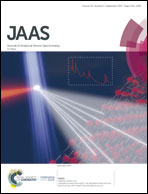Study on carbon-induced signal enhancement in inductively coupled plasma mass spectrometry: an approach from the spatial distribution of analyte signal intensities†
Abstract
To obtain further insight into the mechanism of carbon-induced signal enhancement, accurate quantification of carbon-induced signal enhancement in inductively coupled plasma mass spectrometry (ICP-MS) has been examined. Spatial intensity distributions and axial intensity profiles of the analyte ion (M+) in ICP were obtained by measuring elemental solutions with and without carbon (i.e., 5% (v/v) 2-propanol, IPA). Addition of 5% (v/v) IPA significantly spread and shifted the M+ intensity zone, particularly in the axial direction, toward the sampling cone. The result indicated that the carbon-induced zone-shift in the axial direction should be considered for accurate quantification. As an index for quantifying carbon-induced signal enhancement, an enhancement factor (EFsum), was defined based on the axial intensity profiles by dividing the sum of analyte signal intensities for axial sampling positions from 4 to 15 mm, obtained with 5% (v/v) IPA, by the sum of those obtained without 5% (v/v) IPA. The EFsum values were estimated for 26 elements with a wide range of first ionization energies (IEs) and analyte oxide bond dissociation energies (BDEs). There was no clear relationship between EFsum values and IEs or BDEs of elements, even though the existing hypotheses about the mechanism of carbon-induced signal enhancement have suggested that IE or BDE was a major factor that determines carbon-induced signal enhancement. Large EFsum values were estimated for P, As, Se, and I. Chemical forms of these elements in elemental solutions are oxoacids in common. The results might imply that a mechanism that depends on the chemical forms of elements is also involved in carbon-induced signal enhancement.



 Please wait while we load your content...
Please wait while we load your content...